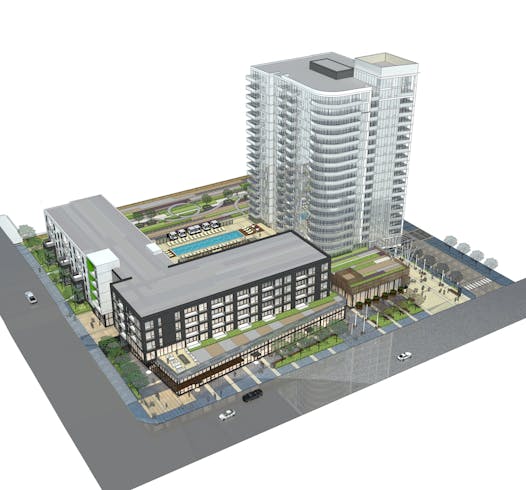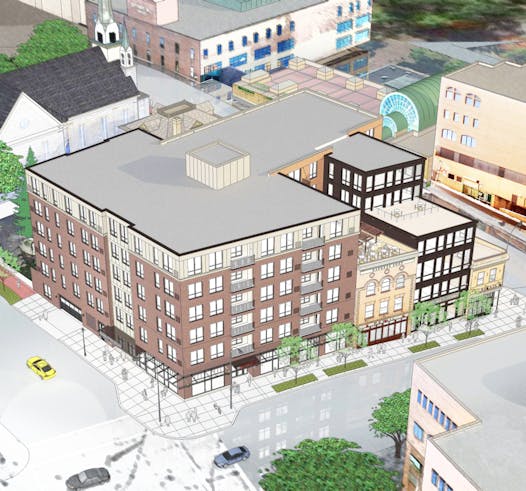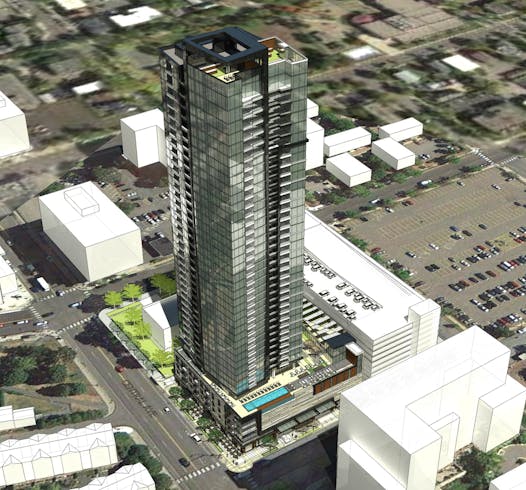They've danced the last polka and served the last pierogi at Nye's Polonaise Room, and soon the wrecking balls will move in as construction of a luxury apartment building starts.
That mixed-use building is just one of several major developments slated for the area in the coming year, all of which will bring hundreds of new apartments to a historic neighborhood just across the river from downtown Minneapolis.
These projects are ushering in a new era for these old neighborhoods, which have become an extension of the downtown development boom. Four major projects, including three high-rises, are now in the works in one of the hottest destinations for developers.
"It's kind of got everything that you want downtown but in a more neighborhood-like setting," said Maureen Michalski, director of development at Schafer Richardson, which is redeveloping the Nye's site.
The Nicollet Island East Bank and Marcy Holmes neighborhood associations have largely supported such development, and in some cases they have have even rejected proposals because they weren't big enough. But the projects have also brought controversy.
Some neighbors and longtime businesses worry that the inundation will alter the area's character and create the same hassles that are found downtown.
Anna Christoforides, co-founder of the Gardens of Salonica restaurant in the heart of the affected district, said the latest wave of development is a serious departure from what makes the area appealing.
"We've accepted the fact that yet another charming, authentic neighborhood will be plowed into a graceless series of high-rise bunkers," she said. "We would expect more foot traffic, but our 25-year loyal customers may be forced away when parking becomes a premium."
Each project has faced its own hurdles, but all are making progress. Two have been approved by the city, one is working its way through the public process and the other is finalizing design renderings and details.
As the birthplace of Minneapolis, this district is one of the oldest parts of the city, beloved for its history and for retaining its pedestrian-friendly vibe. The area, lining the east bank of the Mississippi River, stands in contrast to the skyscrapers filling downtown just across the river.
But Melissa Surdyk, a fourth-generation operator of Surdyk's Liquor and Cheese Shop and vice president of the Northeast Business Association, believes the influx of people could be good as long as the neighborhood is carefully maintained.
"We've been a business in the neighborhood for over 80 years. There was nothing around here at all years ago. We would have to drive to get lunch because there just wasn't anything around," Surdyk said. "It's good to have new things, new people around."
The business association is generally positive about the latest batch of projects — and swelling population — these developments will bring, but with one major concern: parking.
The business owners, Surdyk said, are focused on preserving the character of the neighborhood and making sure that it's easy for residents and visitors to park.
That's an issue that developers and the city are often at odds over. As a part of the city's pro-public transit agenda, officials often push developers to minimize the number of parking spaces in high-density, high-growth neighborhoods in order to encourage bikes, buses and people on foot. Meanwhile, developers worry that a lack of parking in their projects will scare off residents who still own a car.
Schafer Richardson's initial proposal for a 29-story high-rise at the Nye's site included several floors of aboveground parking beneath the tower. The neighborhood and several city committees rejected that design. The final plan, for a building that is only six stories tall, will incorporate the first electrical car lift in a Minneapolis residential building parking garage. It will squeeze in an additional 14 spaces by stacking the vehicles.
Mortenson has also faced some neighborhood resistance to its above-grade parking garage, leading to the design of a colorful screen that's intended to conceal the multistory garage. The developer has not released updated design concepts for the project's parking ramp in several months.
The neighborhood saw its first significant wave of redevelopment in the early 1980s when several high-rise condo and apartment towers were built. That's when some of the most historic buildings in the area were converted into the shops at St. Anthony Main and Riverplace along a cobblestone street.
And during the past few years, nearly 1,000 rental apartments have been built or created through the conversion of existing buildings, including the Pillsbury A Mill, once the largest flour mill in the world. Bader Development and Nolan Properties Group are in the process of turning a pair of rundown brick warehouses into 80 apartments and retail space. The company also plans to build another six-story building on the same site.
From a developer's perspective, the shift across river isn't because there's a shortage of prime development sites in downtown; it's more a reflection of the attributes of the neighborhood, including better accessibility to the Mississippi itself.
"It's an established neighborhood that has the infrastructure in place that people are looking for in terms of restaurants, groceries and walkability, said Bob Lux, developer of the tallest of the four projects, a 40-story condominium tower.
Lux said that integrating high-rise development into the low-rise streetscape will improve the neighborhood by adding more residents to support shops and restaurants.
Bob Solfelt, vice president and general manager at Mortenson, which is refining its design for a 28-story tower that would abut Surdyk's, said "it's a perfect location for individuals and families" who want to enjoy city life.
Peter Chmielewski, vice president of development at Lennar Homes, said the company's proposal to redevelop the nearby Superior Plating factory site was supported by the neighborhood association. One of the objectives was to create a project that would complement the existing streetscape.
"We're not just putting in a high-rise in the neighborhood," he said. "We're building that building around the personality of the neighborhood and the personalities of the people who live there."
Chmielewski compares the area to the West Loop neighborhood in Chicago, which has undergone a similar renaissance but has retained some of its 19th century character.
"There's such an authenticity and history in that neighborhood," he said. "I see a lot of growth now and in the future."
Jim Buchta • 612-673-7376
Kristen Leigh Painter • 612-673-4767

Ambi Subramaniam and Kaushiki Chakraborty to Minnesotans: Lean in on Indian classical music, it's fun
8 months in jail for Blaine man who caused 120-mph crash hours after he was caught speeding

Daughter sues St. Paul, two officers in Yia Xiong's killing






